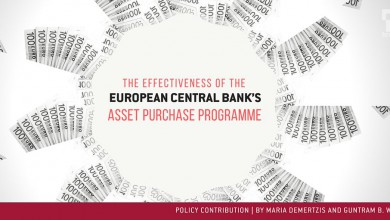Spain and the United Kingdom are well ahead in the road to economic recovery [ref]See i.e. “Spain’s recovery boosts labour market“, Financial Times, for Spain and “Chart: The UK reaching pre-crisis GDP levels“, Bruegel, for the United Kingdom.[/ref]: real GDP in the third quarter of 2014 grew 3.0% in the UK and 1.6% in Spain compared to the same quarter of the year before. On the back of these developments, both countries are going through a deleveraging process, with their private debt-to-GDP ratios dropping by around 18% in the United Kingdom and 15.5% in Spain from their respective peaks some years ago. However, the mechanics behind the deleveraging process show substantial differences between the two countries.
As Figure 1 shows, the private sector in both countries has undertaken major deleveraging efforts. In Spain, non-financial corporate debt was reduced from 143.8% of GDP in Q3 2010 to 124.8% in Q1 2014. Similarly, the UK’s non-financial corporate debt fell from 105.9% of GDP in Q1 2009 to 87.5% in Q1 2014, i.e. the fall was 19 percentage points in Spain and 18.4 percentage points in the UK. Turning to household debt, it dropped from 87.4% of GDP in Q2 2010 to 75.2 % in Q1 2014 in Spain, and from 101.5% of GDP in Q4 2009 to 87.9% in the UK. Hence, the household debt-to-GDP ratio was reduced by 12.2 percentage points in Spain and 13.6 pp in the United Kingdom. Overall, private sector debt-to-GDP-ratios fell 31 percentage points in Spain, and 31.7 percentage points in the United Kingdom – a significant achievement for both countries.

Source: Bruegel calculations based on quarterly data from Eurostat financial accounts
Note: all variables are four period moving averages; Private debt is defined as the stock of liabilities held by the sectors non-financial corporations and households and non-profit institutions serving households. The instruments that are taken into account to compile private sector debt are debt securities and loans.
To better understand these developments, we divide the reduction of the private debt-to-GDP ratio into its four components: economic growth, inflation, the financial surplus (i.e. the sum of net financing (lending minus repayments)) and changes in the valuation of liabilities and other “volume” changes, such as debt cancellations and write-offs, as shown in the formula below [ref]See also Garrote, Daniel, Jimena Llopis and Javier Vallés, ‘Private sector deleveraging channels: an international comparison’, Bank of Spain Economic bulletin, November 2013.[/ref].
Where ΔDebt is the difference of private debt to GPD ratio between period t and t-1, g is real GDP growth and π is inflation (GDP deflator). When analyzing the developments in each component, a number of differences show up.
First, real GDP slumped in both countries in 2008/9 as a result of the financial crisis, followed by a recovery in 2010. As Figure 2 reports, the UK experienced some slow-down, with real GDP hovering around 0% in 2012, but recovered significantly from 2013 onwards. By contrast, Spanish real GDP growth fell into in negative territory for nine consecutive quarters (from Q4 2011 to Q4 2013) and turned positive again only in 2014Q1.

Source: Eurostat
Second, inflation has been falling in both countries since mid-2013, but as Figure 3 shows, the downward trend is significantly more pronounced in Spain, which saw inflation lingering around zero in the second half of 2013 before falling into outright deflation during most of 2014. Conversely, the UK headline inflation continued to stay around 2% in the 2013, before dropping steadily over the last four months to 1.5% in September 2014.

Source: Eurostat
These different inflation behaviors reflect two different ways to adjust after the crisis. Figure 4 reports the real effective exchange rate vis-à-vis the Euro area 18 deflated by the GDP deflator in Panel A, and by nominal unit labour costs in Panel B. Both panels suggest that relative price adjustment has been going on for quite some time in both countries, albeit at a different pattern. The United Kingdom in particular devalued massively in bilateral terms during the height of the financial crisis (see Figure 5) – which explains nearly entirely the drop of its real effective exchange rate against the EA18 (Panel A and B in Figure 4). The Spanish adjustment started somewhat later, in 2009, and was done through internal devaluation – especially the adjustment in the real effective exchange rate deflated by nominal unit labour costs in Spain has been impressive, falling by around 13% over the last 5 years.

Source: European Commission
Note: 2005 = 100; The REER aims to assess a country’s price or cost competitiveness relative to its principal competitors in international markets. It corresponds to the nominal effective exchange rate (NEER) deflated by price (Panel A) or cost (Panel B) deflators.

Source: ECB
Overall, the UK therefore did not have to resort to lower inflation rates to boost its competitiveness but rather used the nominal exchange rate. For Spain, its competitiveness however clearly depends on its domestic inflation rate relative to the inflation rate of the euro area as a whole.
How have these different developments in inflation and GDP growth impacted on the debt reductions in both countries?
Going back to the definition of the channels of debt deleveraging, we can trace the contribution of each factor to the reduction of the debt ratios since their peaks. This exercise is done for the corporate and the household sector in Spain and in the United Kingdom (Figure 6). Both the UK and Spain have seen similar reductions of debt-to-GDP in the corporate sector (see Panel A). However, the factor contribution varies significantly between the countries. While inflation and GDP growth, and to a lesser extent a contraction of net financing flows, played a major role in the United Kingdom, in Spain negative GDP growth actually increased the overall debt-to-GDP ratio, with inflation playing barely a role. Most of the reduction in the Spanish corporate sector was therefore driven by a contraction of borrowing in the non-financial corporate sector as well as negative valuation effects [ref]As highlighted by the Bank of Spain Economic bulletin November 2013, valuation includes debt cancellations and write-offs, which arose i.e. from the transfer of banks’ real estate sector-related assets to Sareb (the Spanish “bad bank”) – a sign that debt resolution is working.[/ref].
Turning to the household sector in the United Kingdom, the debt-ratio was again lowered through real GDP growth and inflation. Also valuation effects played a role in reducing the debt-to-GDP ratio, as financial institutions renegotiated conditions for loans at risk of default. Conversely, net financing by households drove the debt-to-GDP ratio actually up, suggesting that British households are taking on debt again. The picture looks quite different for Spanish households: real GDP growth, inflation and valuation effects impacted the debt-to-GDP ratio only marginally, while most of the reduction was driven by a reduction in net financing, reflecting efforts to repay debt and a fall in new credit.

Source: Bruegel calculations based on Eurostat financial accounts
Note: The respective peaks for corporate debt are Q1 2009 for the United Kingdom and Q3 2010 for Spain, while for household debt the respective peaks are Q4 2009 for the United Kingdom and Q2 2010 for Spain. Inflation is measured by the GDP deflator; Net financing is the incurrence of liabilities minus the repayments of debt; Valuation effects and write offs are “other changes” taken from the Eurostat financial accounts.
In sum, the analysis suggests that deleveraging is taking place through very different channels in the two countries. Spain underwent the painful version of deleveraging, with reductions being driven mainly by credit contraction in both the corporate and the household sector. By contrast, the reduction of the private debt-to-GDP ratio in the United Kingdom was achieved mostly through real GDP growth and inflation, the latter eroding the real value of debt. Looking ahead, it is important to highlight that GDP just started to grow in Spain, and could play a role in in reducing private debt to GDP levels in the coming years, contrary to inflation which is falling even further into negative territory. Overall it would be desirable to see the denominator play a more significant role in Spain to safeguard the full potential of economic recovery, as demonstrated so far by the United Kingdom. It is therefore of central importance that inflation rates in the euro area do not fall but rather increase back to the target of close but below 2%. That would greatly facilitate the debt deleveraging in Spain while at the same time allowing Spain to regain competitiveness relative to the rest of the world.


